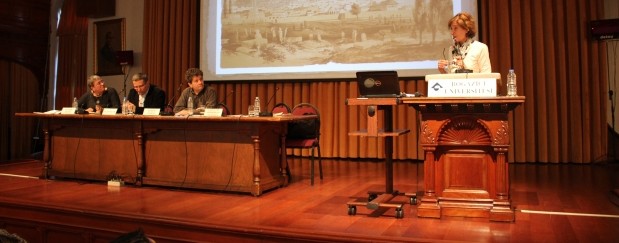23 November 2015
On November 20 and 21, the Hrant Dink Foundation in Istanbul held the latest in a series of groundbreaking historical conferences. The 2015 edition was entitled ‘A Civilization Destroyed: The Wealth of Non-Muslims in the Late Ottoman Period and the Early Republican Era’. The conference organized in cooperation with Bogazici University, Istanbul Bilgi University and Sabanci University was held with broad participation at Bogazici University, Albert Long Hall. The conference, which received much attention, was broadcasted live on www.hrantdink.org website both in English and in Turkish.
Hrant Dink Foundation President Rakel Dink, Bogazici University Rector Gülay Barbarosoğlu, Istanbul Bilgi University Rector Mehmet Durman and Sabancı University Rector Nihat Berker made the opening speeches of the conference. The history of expropriation and destruction of the wealth of non-Muslims through policies of annihilation of minorities and Turkification in the Late Ottoman and Early Republican Period was explored with an interdisciplinary perspective.
A total of 27 papers were presented at the meeting which was attended by 29 scientific researchers from 11 countries. The papers of ‘A Civilization Destroyed: The Wealth of Non-Muslims in the Late Ottoman Period and the Early Republican Era’ conference, the fifth academic meeting of the Foundation within this framework, will be published into a book and brought to the attention of scientific researchers.
DAY 1
Conference began with the first panel titled ‘Historical Background’ under the chairmanship of Ayhan Aktar. The presentations of Abdülhamit Kırmızı, Mustafa Erdem Kabadayı, and Nilay Özok Gündoğan were followed by the second panel, chaired by Ahmet İnsel, titled‘Labor Mobility and Economic Activity’. Jelle Verheij presented his paper titled ‘Armenian Rural Migration to Istanbul in the 1890s: The Migrant Profile’. He focused on chain migrations of Armenians and seasonal labor. Sinan Dinçer delivered his presentation, ‘The Rise and Fall of the Armenian Migrant Networks’ which addresses the change in Armenians’ migration behavior in the 19th century and post 19th century period.
Following the lunch break, Edhem Eldem chaired the third panel titled ‘Specific Regions and Groups – I’. After Zeynep Kezer’s presentation which explores the changing landscape and architectural structure in the region after the 19th century, Elçin Macar brought confiscated non-Muslim wealth in Cilicia up for discussion with his paper titled ‘Confiscated Properties of the Cilicia Armenian Catholicosate in Adana-Kozan (Sis)’. Then Caroline Mesrobian Hickman presented her paper which discusses Armenians’ status in Afyon Karahisar’s economic life.
The last panel titled ‘Specific Regions and Groups – II’ was chaired by Ayşe Kadıoğlu. While Eyal Ginio touched upon the environment of cultural and political exclusion experienced by non-Muslims in Dimetoka, Giordano Altarozzi & Iulia Alexandra Oprea shared the stories of last Levantines in Istanbul. The session ended with Dimitris Stamatopoulos’s presentation. He narrated examples from the archive of Mirmiroğlu, the lawyer of the Rum families who left Istanbul.
DAY 2
The second day of the conference began with the fifth panel titled ‘Personal and Family Accounts’. Oya Güzel Durmaz, Jonathan Conlin and Sezai Balcı delivered their presentations in the panel chaired by Leyla Neyzi. Oya Güzel Durmaz narrated the story of Ibranosyan, a deported Armenian merchant, while Jonathan Conlin discussed Gulbenkian family and Sezai Balcı talked about the life of Captain Yorgi Konstantinidi, Mayor of Giresun.
Bülent Bilmez chaired the sixth session titled ‘Legal and Religious Coercion’. Mehmet Polatel explored the discussions and regulations related to the return of the seized Armenian properties and Hilmar Kaiser’s presentation was titled ‘Movable Armenian Property in 1915’. Anush Hovhannisyan addressed the issue of forcible Islamization as a mechanism of transferring of Armenian property. Finally, Hamit Bozarslan interpreted the economic plunder and demographic homogenization in the Armenian and Jewish Genocides alongside the following results of the destruction of culture and civilization.
The first session of the conference after lunch break was titled ‘After the Spoliation’. In this seventh session, chaired by Ayfer Bartu Candan, Ümit Kurt, Ellinor Morack, Emre Eldem, Oktay İnce and Nevzat Onaran made their presentations. Speakers elaborated on the theme of Abandoned Property in the Late Ottoman Period and the Early Republican Era from different perspectives.
Ümit Eser, Francesca Penoni, Fırat Güllü and Stefani Kundakjian presented their papers in the last panel which was titled ‘Cultural Losses’and chaired by Suavi Aydın. Eser, Penoni and Güllü focused on the destruction of heritage in the Late Ottoman and Early Republican Period through the themes of architecture and theatre. Finally, Stefanie Kundakjian made a presentation on the the value of Armenian women and children as ‘currency’ in the geography of the period. The conference ended with General Evaluations and Discussions, chaired by Cengiz Aktar.
AGBU Europe coordinates and develops the pan-European activities of the Armenian General Benevolent Union. The AGBU Europe District furthers this mission by raising awareness of Armenian causes through advocacy in European communities and in EU public affairs arenas. AGBU is supportive of the objectives and of the programmes of the Hrant Dink Foundation. As part of this cooperation, AGBU Europe contributes to the dissemination of information about the work of the Hrant Dink Foundation in the Armenian diasporas in Europe.

